Staff Augmentation: All-In-One Guide and Useful Hints


Resource and staff augmentation is widely associated with project outsourcing, which isn’t correct. It is a stand-alone term that defines the process of drawing external resources to an in-house team upon a need.
The staff augmentation model helps tackle technical debt, lack of resources, or other issues by hiring external talents and integrating them into your in-house team. Augmented staff can be hired with the help of an external agency.
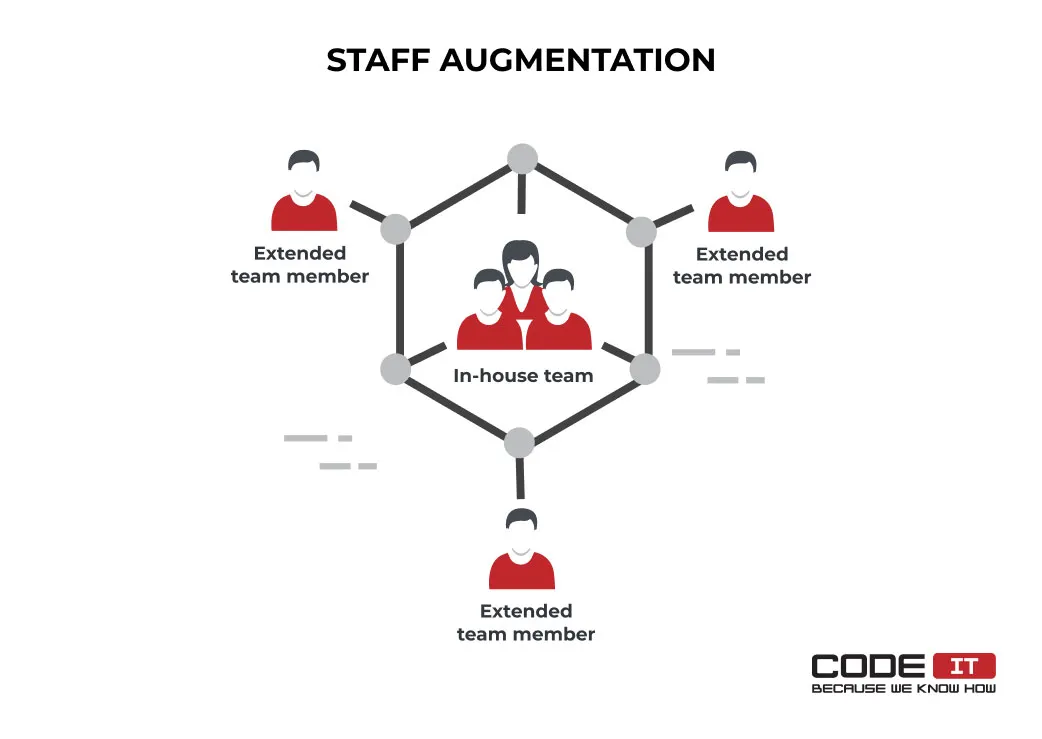
The model offers outstanding flexibility so that businesses can draw experts and compose versatile teams to meet their business goals. They can hire experts in different industries to fill gaps fast and stress-free. Moreover, they can replace talents upon need or hire experts for a short period to tackle specific tasks.
Staff Augmentation Process
How does staff augmentation work? Let’s find it out by discovering how to assemble an augmented team.
The staff augmentation process needs you to take four crucial steps:

1. Define Requirements
For starters, it’s necessary to analyze your internal processes to understand what problems should be tackled by hiring augmented team members.
Find positions in your team that should be filled with external specialists to achieve your business goals. Resource and staff augmentation can help solve the following problems:
- lack of technical skills
- shortage of software engineers
- lack of niche-specific expertise
- lack of time to release a product
- unforeseen team composition issues
In essence, you should get a document with roles that should be filled with augmented staff. Also, it’s vital to clearly define skills, years of experience, and required software knowledge to add the best talents to your team.
2. Find a Tech Partner
Many outsourcing companies provide staff augmentation services. Feel free to use the Internet to find popular outsourcing companies or ask your connections to share references.
Also, you can explore trusted B2B listings to find top-rated companies. The most popular are:
After selecting the top companies that offer resource and staff augmentation services, assess the following to find the best vendors:
reviews submitted by verified clients
successful case studies
a company’s workflow
years of experience
number of employees
niche-specific expertise
Shortlist the best companies and get in touch with their representatives, sharing your requirements. Discover whether selected companies can fulfill your demand. Feel free to ask the following questions:
How much time will it take to allocate the required specialist?
Can I interview and select tech talents by myself?
How much will I need to pay?
Are there any additional or hidden fees?
Do you help onboard augmented experts?
After researching and finding the best staff augmentation vendor, we recommend preparing and signing a non-disclosure agreement (NDA) to keep all the internal information safe. Besides, prepare and sign a contract that outlines all the cooperation details.
Partner with us to draw top tech experts to your team!

Business First
Code Next
Let’s talk
3. Select Augmented Staff
Some companies select and provide the requested experts without any clarification from their clients.
In case you’re involved in the talents selection process, we recommend taking the following steps:
Review candidates
Ask the hired vendor to share the CVs of all their team members. Review the resumes to gather a team of augmented talents that will supplement your in-house team best.
We recommend preparing a document that outlines technical skills standards. It will help you avoid unmatched expectations when choosing the staff augmentation model.
Conduct interviews
Schedule one-a-one interviews with selected candidates to gauge their values, communication skills, and personal preferences. It’s vital to hire specialties and assign them to projects that they find inspiring to achieve maximum productivity.
Assess tech skills
Examine the technical skills of the reviewed candidates. You can assess hard skills using the following methods:
- Tech task. Prepare a technical task and share it with selected candidates, providing a deadline to submit it.
- Tech interview. Involve a tech specialist and schedule an online interview. The tech expert should ask prepared questions and assess the answers shared by interviewed candidates in live time.
- Third-party platforms. Many online services help examine the hard skills of potential employees. The most popular are Codility, CodeSignal, and TestGorilla. They assess technical skills and provide detailed reports.
4. Onboard Extended Team Members
The final step of staff augmentation is integrating new members into your in-house team.
If a hired company doesn’t provide support in onboarding extended employees, you should take the following steps:
Prepare an onboarding plan
Create a document that defines all the steps to take to integrate an extended employee into the existing in-house team. It may have a form of a spreadsheet, block diagram, etc.
Hold the introduction meeting
Schedule welcome meetings with new team members. Share information about your company, products, values, clients, other team members, etc.
Help new employees better understand your company and the business goals you strive to achieve. Also, the introduction meeting aims to erase any possible uncertainty and eliminate any concerns.
Create a communication and collaboration environment
Establish collaboration and communication tools for seamless staff augmentation. Help new employees start working without delays. It’s advisable to set up the following in advance:
- corporate accounts
- task management tools
- communication tools
Educate new employees
Prepare thorough instructions so that new team members can quickly understand the workflow in your company. The instruction should imply all the required actions to perform job responsibilities.
If you use custom-built software in your company, it’s advisable to conduct a workshop to help new employees understand how to use custom tools.
Assign a mentor
It is an optional step to help you integrate a new employee into your team seamlessly.
A mentor is an in-house team member who guides an extended employee, helping them start working at a high-performance level as quickly as possible.
Usually, a mentor should do the following:
- conduct short daily mentorship meetings
- answer questions about the workflow or product
- help nail down unexpected issues
- supervise the work
- submit feedback
Since mentorship takes additional effort and time, the mentors’ backlogs of tasks and KPIs should be adjusted accordingly.
How To Manage An Augmented Team
In most cases, extended developers hired using the staff augmentation approach work remotely. Hence, insufficient project management is one of the most widespread augmented team issues. Below, you will discover how to manage an augmented team to achieve maximum performance.
An in-house project manager should be responsible for supplying new team members with the required number of tasks and monitoring their compilation. A hired vendor can provide a dedicated specialist to manage a team of developers or other experts.
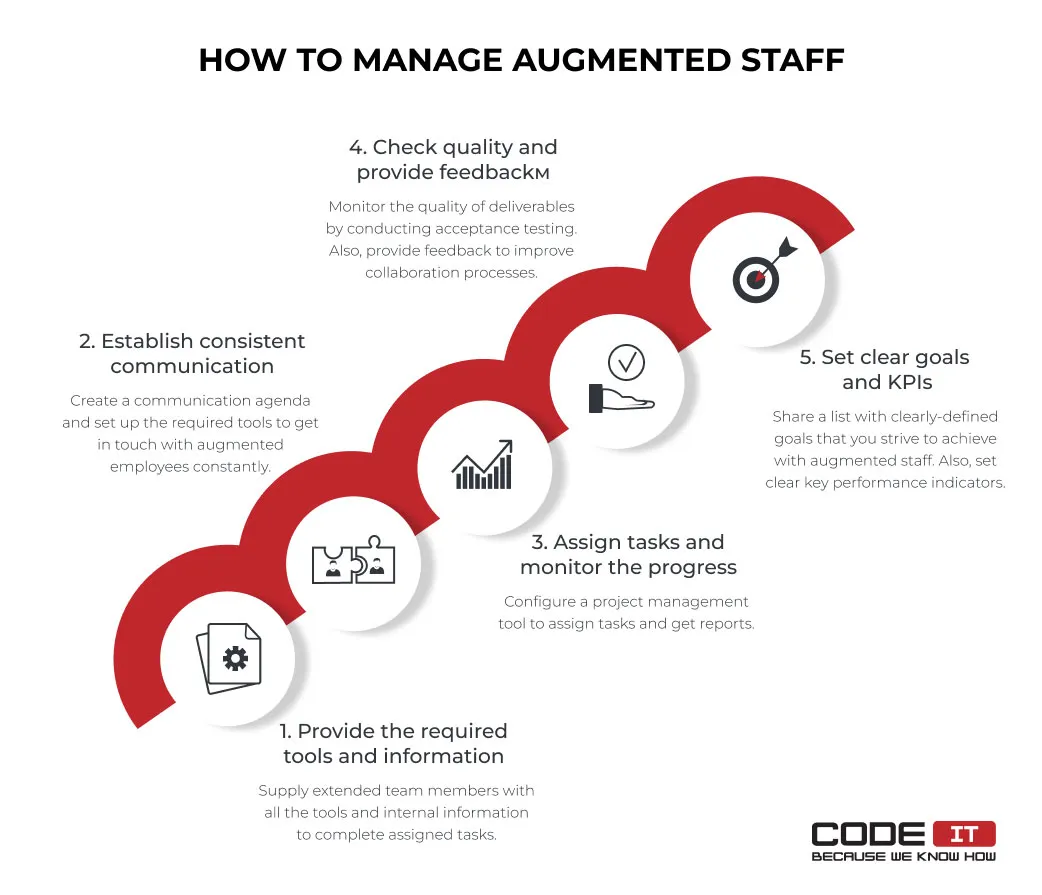
In case you manage the entire team by yourself, it’s advisable to take the following steps:
1. Provide Required Tools and Information
It’s vital to establish a workspace that helps new experts work at a high pace without the need to search for additional tools or information.
It’s necessary to provide access for new users to internal resources and tools. For example, you should share a product vision statement with extended team members when building a new product. It will help them better understand the strategic goals you strive to achieve.
2. Establish Consistent Communication
Ensure new employees can communicate with all your in-house team members to create a collaborative environment.
The most popular tools used for business communication are:
Also, create a communication agenda to constantly get in touch with extended employees. Feel free to ask about progress, challenges, ideas, and other details when communicating with augmented developers.
For instance, daily stand-up meetings are a part of the Agile software development methodology. They can help the product owner to stay updated about all the tasks’ completion progress and challenges that need urgent responses.
3. Assign Tasks and Monitor Progress
Create a document that implies tasks to assign to new team members when adopting the staff augmentation approach.
If using the Agile product development methodology, you can prepare a backlog. It can be a source of tasks for every sprint.
The most popular digital tools used by businesses for project management are:
Don’t hesitate to conduct regular meetings with extended team members to discuss the challenges they experience and collect feedback. It can help improve collaboration processes to achieve better performance.
4. Check Quality and Provide Feedback
Assess the quality of deliverables created by augmented team members and share feedback. Feel free to highlight points that should be improved. Also, it’s vital to conduct acceptance testing to ensure that all the requirements are met.
In order to facilitate the quality assessment process, it’s advisable to set the following:
- Quality standards. A list of product quality standards that should be met to pass acceptance testing.
- Definition of done (DoD) criteria. A list of criteria that help define if a task is completed.
5. Set Clear Goals and KPIs
Extended employees need to clearly understand the number of tasks required to complete to meet the company’s standards.
Analyze the performance of your in-house team members to set clear key performance indicators (KPIs) that should be met by experts hired using the staff augmentation model.
When using the Agile product development methodology, KPIs can be measured in story points. A project manager should assign a different number of story points to tasks, depending on their complexity.
Draw tech-strong experts along with a skilled project manager at CodeIT!

Business First
Code Next
Let’s talk
Security Measures When Hiring External Team Members
It’s vital to establish a secure collaboration environment when integrating third-party members into your team. Down below, you will find the top measures to keep your business safe.
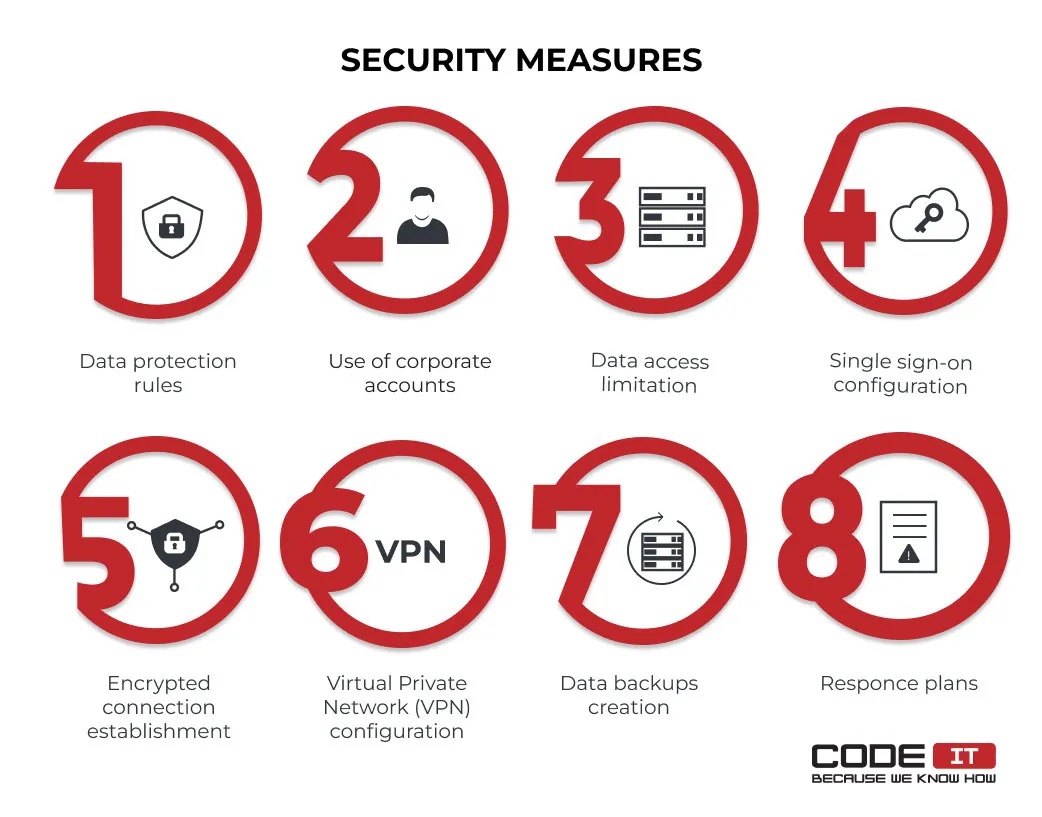
1. Create Data Protection Rules
According to the research conducted by Weforum, 95% of cybersecurity issues are caused by human error. Therefore, you should educate your employees on how to use and share internal data by preparing thorough guides.
2. Create Corporate Accounts
Set up corporate accounts for new team members involved using the resource and staff augmentation model.
For instance, using Google Workspace, you can create accounts for new employees, set permissions, track activity, disable accounts, etc.
3. Limit Data Access
Provide extended team members with access to the required data sources only.
In the case of using Google Workspace in your organization, you can share documents with certain users by email. Also, you can assign a manager who will share the required documents upon request.
4. Configure Single Sign-On
The single sign-on (SSO) is an authentication scheme that foresees the ability to provide and control access to many independent tools used by employees involved using the staff augmentation method. Workers can use the only credentials to log in for different digital tools.
The admin user thoroughly monitors the SSO. Hence, access to all the tools provided to an employee can be suspended rapidly with a few clicks.
5. Establish Encrypted Connections
Share all the files and data using an encrypted connection. The secure shell (SSH) protocol is the most popular solution that helps transfer data using the Internet securely.
6. Configure a Virtual Private Network
Using a virtual private network (VPN) is one of the most popular solutions to manage access control.
With the help of a VPN, extended employees can securely access your organization’s network from different locations. Also, you can grant access to your company’s resources via VPN only to enhance security.
7. Create Data Backups Regularly
Unfortunately, there is no 100% reliable way to keep your company safe from breaches or data loss.
Therefore, it’s advisable to create data backups regularly. Store backed-up data using cloud storage or dedicated hard drives.
8. Prepare Response Plans
Analyze possible risks that may negatively impact your organization’s security and prepare response plans. It will help you quickly respond to new challenges without wasting time finding the best solution.
Partner up with a trusted company to achieve success!

Business First
Code Next
Let’s talk
Team Augmentation Alternatives
The staff augmentation model is one of many solutions businesses can opt for to address the lack of employees.
The two most popular alternatives to technical staff augmentation are:
- Project outsourcing. It is the process of delegating software development tasks to an external vendor.
- Freelance workers hiring. It is the process of involving freelance workers to complete tasks.
Let’s compare the two most popular alternatives to team augmentation in more detail.
| Staff Augmentation | Project Outsourcing | Freelance Workers | |
|---|---|---|---|
| Purpose | To fill talent gaps fast and stress-free. | To delegate a project to an outsourcing company. | To involve workers in completing small tasks. |
| Cost | Business owners need to compensate for the time spent by extended employees. | Business owners need to pay a defined fee that agency’s representatives estimates. | Business owners need to compensate for the time spent by freelance employees and cover extra hiring fees. |
| Time To Start | Fast. Augmented team members can be allocated and onboarded in a few days. | Moderate. An agency’s representatives need to estimate a project and allocate the required resources. | Slow. A business owner is required to find a freelance worker to start a new project. |
| Scouting and Hiring | No scouting and hiring issues. Business owners need to select the best candidates offered by an agency. | A hired agency is responsible for hiring the right talents to complete all the tasks on time. | A business owner is required to find freelance workers, assess their skills, and hire them. |
| Onboarding | A business owner is required to onboard extended employees. Some firms provide talent onboarding assistance. | No team members should be onboarded. | Onboarding may not be required to complete small tasks. |
| Control | Complete control. Extended employees supplement the existing in-house team. | Lack of control. A hired agency manages the completion of delegated tasks. | Moderate control. Freelance workers can hardly be supervised. |
| Commitment | Augmented employees commit to completing assigned tasks upon scheduled deadlines. | An outsourcing company commits to deliver a product defined by an agreement. | Freelance workers may not complete assigned tasks without reason. |
| Tech Skills | Top-tier experts are scouted and selected by a staff augmentation agency. | An external vendor hires the best talents to complete assigned tasks. | A business owner should thoroughly assess tech skills. |
| Scalability | Business owners can quickly draw new team members with different tech skills. | Team scaling issues are managed by an external vendor. | New freelance employees should be scouted and hired to enlarge a team. |
Pros And Cons Of Staff Augmentation Model
The staff augmentation model is widely chosen by businesses that need to hire new talents fast and stress-free due to its many advantages.
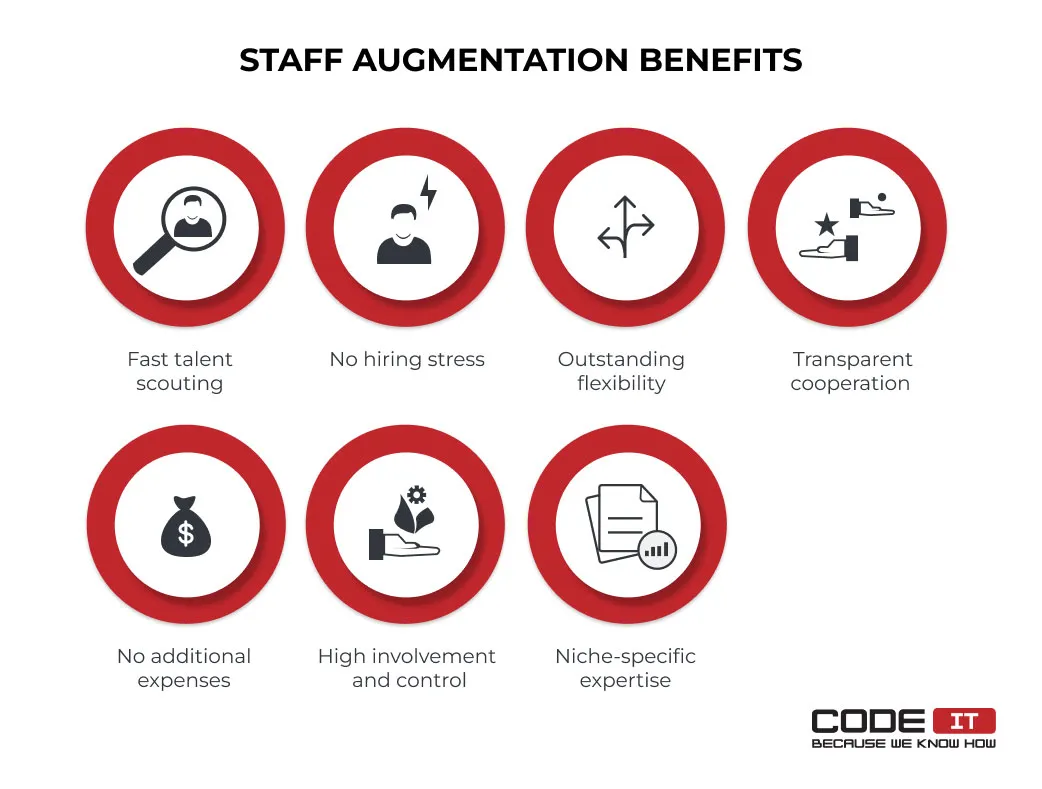
The main staff augmentation benefits are:
- Fast talent scouting. With many skilled experts ready to start, staff augmentation agencies can quickly allocate the required team members to a client’s project.
- No hiring stress. When choosing the staff augmentation model, businesses don’t need to launch hiring campaigns, interview candidates, search for skilled talents, etc. External vendors help eliminate the hiring stress.
- Outstanding flexibility. Businesses can draw augmented team members to fill temporary positions or change the composition of an extended team upon a need.
- Transparent cooperation. The staff augmentation model needs business owners to compensate for the time extended employees spend only.
- No additional expenses. Business owners don’t need to establish workplaces for extended team members or cover paid leaves.
- High involvement and control. Since augmented employees supplement the in-house team members, business owners can be completely involved in all the processes.
- Niche-specific expertise. Resource and staff augmentation firms can help find tech talents with industry-specific expertise for hard-to-fill positions.
Even though there are many benefits of staff augmentation, the model isn’t perfect.

The more widespread challenges that businesses may face are:
- Demand in a large augmented team. Some augmented staff providers may struggle to allocate a lot of tech-strong specialists, i.e., dozens of developers, to your project in a short period.
- Remote collaboration issues. Since extended team members may be located in different locations, business owners may experience some remote collaboration issues. Time zone differences, language barriers, possible misunderstandings, or other issues cause the most popular ones experienced by business owners who select staff augmentation over reaching out to outsourcing companies.
- Insufficient technical expertise. In exceptional cases, businesses that draw augmented team members may be unsatisfied with new members’ tech expertise level.
- Challenging onboarding. Additional training may be required to integrate extended team members into the existing in-house team.
How Do I Tackle Team Augmentation Challenges?
All the challenges businesses may face when choosing the staff augmentation model can be overcome.
Let’s check how to cope with the top four most popular staff augmentation issues mentioned above.
Demand in a large augmented team
Unfortunately, the majority of augmented staff providers can hardly allocate a large number of experts to a client’s project. It is unprofitable for many companies to hold dozens of tech experts, expecting a new client to draw these experts.
If you need to scale up your in-house team by quickly adding dozens of new tech-strong experts, we recommend hiring an agency with outstanding scouting expertise. Hence, a hired staff augmentation agency can help scout new employees rapidly.
Remote collaboration issues
When launching the staff augmentation project, it’s vital to establish transparent collaboration and communication environments. The following actions can help solve the most widespread remote collaboration issues:
- create a working schedule for remote employees
- create a communication agenda
- set clear tasks with the definition of done criteria and deadlines specified
- create meeting notes and share them with extended employees
- supervise augmented workers and provide feedback
Insufficient technical expertise
Create a list of tech skills standards in your company and share it with a contractor to avoid mismatching.
Also, double-check the skills of extended employees when choosing the technical staff augmentation.
Challenging onboarding
We recommend choosing a staff augmentation provider that offers onboarding assistance. It will help you eliminate stress if you have no expertise in onboarding new team members or cannot afford to allocate time for additional training.
Hire augmented staff at CodeIT stress-free with our battle-tested workflow!

Business First
Code Next
Let’s talk
When To Choose Staff Augmentation Model
Resources and staff augmentation isn’t the one-size-fits-all solution for businesses that need to scale up their teams.
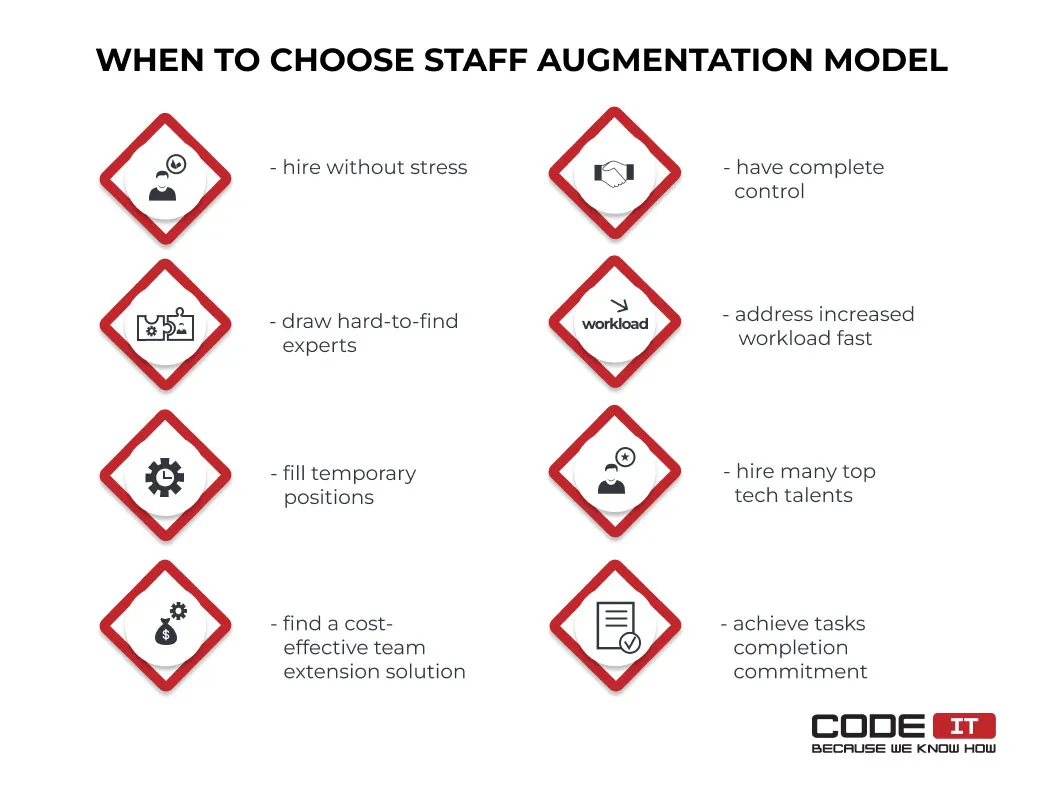
It is worth opting for staff augmentation if you need to:
- Hire stress-free. Team augmentation can allocate the required resources according to the requirements shared by a business owner. It helps get rid of the scouting and hiring hassle.
- Draw hard-to-find experts. An external company can help find talents with niche-specific or extraordinary tech skills.
- Fill temporary positions. Involve augmented team experts in your team for a short period to complete a selected number of tasks or help complete a temporary project.
- Address increased workload fast. Draw new team members fast to complete many tasks without making your in-house team work overtime.
- Have complete control. The staff augmentation model helps completely supervise extended employees and make them involved in your organization’s internal processes.
- Hire many top tech talents. Having a tried-and-tested talent scouting and hiring workflow, a staff augmentation vendor can help find and assemble a large team of experts fast and stress-free.
- Find a cost-effective team extension solution. The resources and staff augmentation need business owners to compensate for the time spent by allocated experts only. No extra expenses or hidden fees affect the final price.
- Achieve task completion commitment. Being a part of an in-house team, augmented employees commit complete assigned tasks.
Codeit Expertise For Staff Augmentation
CodeIT has allocated a team of 28 tech experts to the client’s project. They have been successfully working on the project for seven years, releasing new software continuously.

Problem
The client’s on-site team couldn’t tackle many tasks efficiently. Moreover, they experienced a scarcity of technical skills for implementing a new product. Stakeholders came up with hiring CodeIT specialists and integrating them into the existing team as the best solutions for tackling all the challenges fast.
Solution
First, the client has onboarded two CodeIT software engineers to complete urgent tasks and test the staff augmentation services provided by our company.
CodeIT has established the required working space, communication, and collaboration environments to integrate augmented developers into the client’s team seamlessly.
Stakeholders can easily manage tasks and track the performance of new team members.
Being satisfied with the augmented team, the client has decided to extend the dedicated team to tackle the constantly growing number of tasks effectively. Eventually, 28 tech experts and marketing specialists were added to the client’s on-site team by CodeIT.
Take a deeper look at the case study to learn more about our team’s input.
Final Thoughts On Staff Augmentation
What is staff augmentation? It is the approach that helps business owners scale up their teams by drawing new employees from an external provider.
The main staff augmentation benefits are:
- fast talent scouting
- absence of hiring hassle
- outstanding flexibility
- transparent cooperation
- no additional expenses
- high involvement and control
- access to industry-specific experts
The staff augmentation process implies four steps that are:
- Requirements definition
- Tech partner finding
- Augmented staff selection
- Onboarding of hired employees
FAQ
Staff augmentation is the process of drawing new employees from a third-party provider to an organization’s team.
The main benefits of staff augmentation are:
- fast and stress-free talent scouting
- no hiring hassle
- outstanding flexibility
- transparent cooperation and no hidden fees
- high involvement and control
- ability to find industry-specific experts
It is the agreement between an external provider and a business. The staff augmentation contract outlines all the cooperation details.
It may imply information about the number of extended employees allocated to a client’s project, the number of hours they can work per week, payment rate, billing details, and other crucial information.
Business owners who choose the staff augmentation model draw additional team members from an external vendor. They can completely supervise augmented software developers, assign tasks, etc.
In the case of selecting outsourcing companies, stakeholders delegate projects completed to a third-party company. They have limited abilities to manage and control all the processes.
In order to supplement your in-house team with extended employees, you should follow these steps:
- Define requirements. Prepare a list of positions that should be filled and specify the required tech skills set for every role.
- Find a tech partner. Research to find top-rated staff augmentation providers and examine them to select the best one.
- Select augmented staff. Review the CVs of augmented employees, check their skills, and select the top employees to draw.
- Onboard selected employees. Integrate augmented experts into your team by creating collaboration and communication environments. Also, it’s needed to share crucial information and provide access to the required data.
Many different approaches can be used to manage augmented employees. In order to scale up your team effectively, we recommend doing the following:
- provide access to all the data required to complete tasks
- establish consistent communication
- assign tasks and monitor the progress of their completion
- supervise and provide feedback
- set clear goals and KPIs
When opting for the staff augmentation model, business owners contact an external agency to draw new employees. The approach helps scale up the existing in-house teams by supplementing them with new employees.
In contrast, when opting for the managed services approach, business owners should contact an outsourcing agency to delegate the completion of certain tasks and receive well-defined results.
Build your ideal
software today






